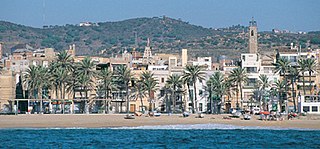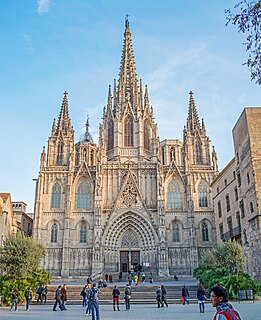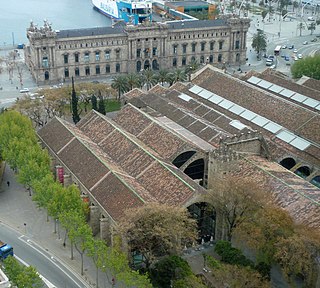
Badalona is a municipality to the immediate north east of Barcelona in Catalonia, Spain. It is located on the left bank of the small Besòs River and on the Mediterranean Sea, in the Barcelona metropolitan area.

The Autonomous University of Barcelona, also known as UAB, is a public university mostly located in Cerdanyola del Vallès, near the city of Barcelona in Catalonia, Spain.

Sitges is a town about 35 kilometres southwest of Barcelona, in Catalonia, renowned worldwide for its Film Festival and Carnival. Located between the Garraf Massif and the sea, it is known for its beaches, nightspots, and historical sites.

Ciutat Vella is a district of Barcelona, numbered District 1. The name means "old city" in Catalan and refers to the oldest neighborhoods in the city of Barcelona, Catalonia, Spain. Ciutat Vella is nestled between the Mediterranean Sea and the neighborhood called l'Eixample. It is considered the centre of the city; the Plaça Catalunya is one of the most popular meeting points in all of Catalonia.

The Gothic Quarter is the centre of the old city of Barcelona. It stretches from La Rambla to Via Laietana, and from the Mediterranean seafront to the Ronda de Sant Pere. It is a part of Ciutat Vella district.

The Palau de la Generalitat de Catalunya is a historic palace in Barcelona, Catalonia. It houses the offices of the Presidency of the Generalitat de Catalunya. It is one of the few buildings of medieval origin in Europe that still functions as a seat of government and houses the institution that originally built it.

Malgrat de Mar is a municipality in the comarca of the Maresme, in the province of Barcelona, Catalonia, Spain. It is situated on the Costa Brava between Santa Susanna and Blanes. A local road runs from the town to the main N-II road, while the B-682 connects it with Blanes, Lloret de Mar and Tossa de Mar. It is served by a RENFE railway station on the R1 line between Barcelona and Maçanet-Massanes.

Olèrdola is a municipality in the comarca of the Alt Penedès in Catalonia, Spain. It is situated on the northern side of the Garraf massif, and the highest point of the municipality is the Puig de l'Àliga at 468 m.

The Barcelona–Vallès Line is an unconnected standard gauge railway line linking Barcelona with Sabadell and Terrassa via the Collserola mountain range, in Catalonia, Spain. Its name refers to the Catalan historical region of Vallès, whereby most part of the line runs. Plaça de Catalunya station serves as the Barcelona terminus of the line, where almost all its trains either start or terminate. The line then continues northwards and branches off twice before leaving the city limits. Its main route splits in two in Sant Cugat del Vallès, forming two major branches to Sabadell and Terrassa. It has 40 passenger stations in operation and a total line length of 48.1 kilometres (29.9 mi).

Rail transport in Catalonia operates on three rail gauges and services are operated by a variety of public operators:
The Battle of Albesa was a follow-up to the Battle of Torà that took place 25 February 1003 at Al-Qaṣr al-Māša (Albesa), near Balagî (Balaguer), between the united Christian forces of the Catalan counties and the Islamic forces of the Caliphate of Córdoba. It was one of the border skirmishes associated with the interminable razzias of the Reconquista, described as "a simple encounter between local forces" and "a local action without overarching importance", though both these views are called into question by the assemblage of important Catalan nobles at the battle and the Muslim reprisal which followed.

Diagonal Mar i el Front Marítim del Poblenou is a neighborhood in the Sant Martí district of Barcelona, Catalonia, Spain.

Catalunya en Miniatura is miniature park inaugurated in 1983 in Torrelles de Llobregat, 17 km from Barcelona. With 60.000 square meters, 35.000 of them devoted to the scale models, it is one of the largest miniature parks in the world, and the largest of the 14 miniature building exhibitions present in Europe. It displays 147 models of palaces, churches, bridges and other buildings from Catalonia and Mallorca and it includes all the major works by the renowned architect Antoni Gaudí.

CaixaForum Barcelona is an art gallery in Barcelona, Catalonia, Spain. It is sponsored by Barcelona bank "la Caixa", and opened in 2002 in a former factory. CaixaForum is located in the Montjuïc area, on Avinguda de Francesc Ferrer i Guàrdia. The museum houses art exhibits.
The Gabinet de les Arts Gràfiques, in English Graphic Arts Cabinet, is a museum opened in 1942 and located in the Palau Reial de Pedralbes in Barcelona. Together with Museu de les Arts Decoratives and the Museu Tèxtil i d'Indumentària is part of the Disseny Hub Barcelona.

Religion in Catalonia is diversified. Historically, virtually all the population was Christian, specifically Catholic, but since the 1980 there has been a trend of decline of Christianity and parallel growth of irreligion and other religions. The secularisation of Catalan culture started in the eighteenth and nineteenth centuries, but conscious disaffiliation from Catholicism has also been driven since the 1980s by the religion's association with Francoist Spain. According to the most recent study sponsored by the government of Catalonia, as of 2016, 61.9% of the Catalans identify as Christians, up from 56.5% in 2014, of whom 58.0% Catholics, 3.0% Protestants and Evangelicals, 0.9% Orthodox Christians and 0.6% Jehovah's Witnesses. At the same time, 16.0% of the population identify as atheists, 11.9% as agnostics, 4.8% as Muslims, 1.3% as Buddhists, and a further 2.4% as being of other religions.

The Maritime Museum of Barcelona (MMB) is located in the building of Drassanes Reials de Barcelona , the royal arsenal of Barcelona, dedicated to shipbuilding between the thirteenth century and eighteenth century. The first mention of these arsenals date from 1243 in a document indicating the boundaries of the city of Barcelona where it mentions its shipyard.




















